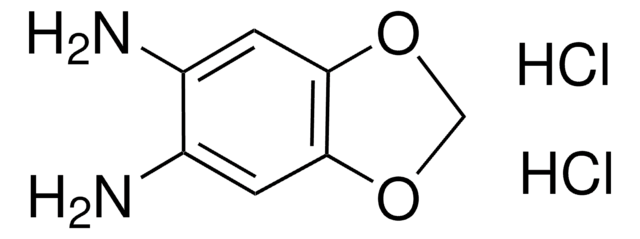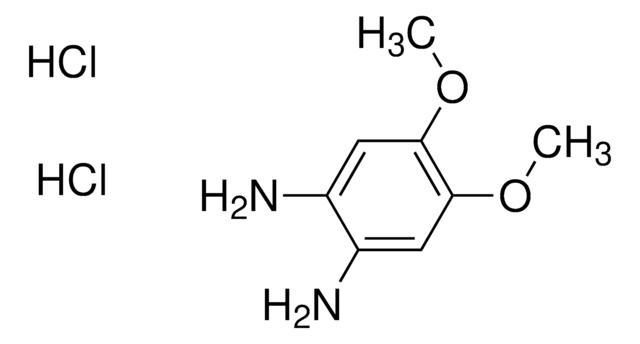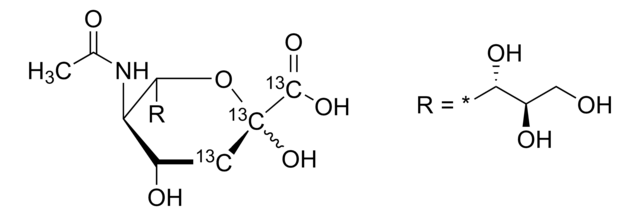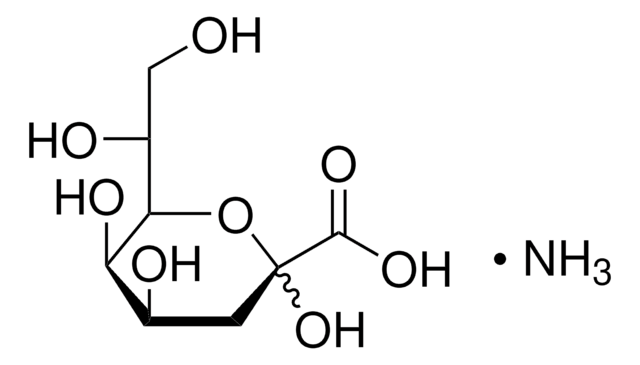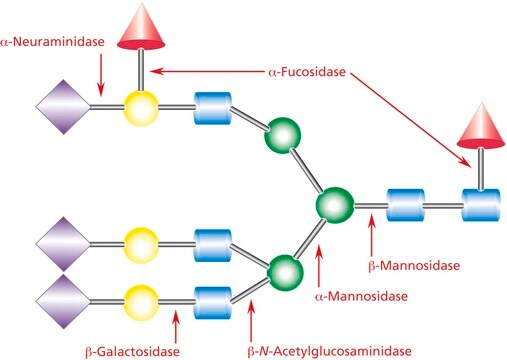50644
N-Glycolylneuraminic acid
≥95% (HPLC)
Synonym(s):
Neu5Glc, NeuNGl
Sign Into View Organizational & Contract Pricing
All Photos(1)
About This Item
Empirical Formula (Hill Notation):
C11H19NO10
CAS Number:
Molecular Weight:
325.27
Beilstein:
1716828
MDL number:
UNSPSC Code:
12352201
PubChem Substance ID:
Recommended Products
biological source
synthetic
Quality Level
Assay
≥95% (HPLC)
form
powder
storage temp.
−20°C
SMILES string
[H][C@]1(O[C@@](O)(C[C@H](O)[C@H]1NC(=O)CO)C(O)=O)[C@H](O)[C@H](O)CO
InChI
1S/C11H19NO10/c13-2-5(16)8(18)9-7(12-6(17)3-14)4(15)1-11(21,22-9)10(19)20/h4-5,7-9,13-16,18,21H,1-3H2,(H,12,17)(H,19,20)/t4-,5+,7+,8+,9+,11-/m0/s1
InChI key
FDJKUWYYUZCUJX-AJKRCSPLSA-N
Looking for similar products? Visit Product Comparison Guide
Application
Glycolylneuraminic acid, a component of non-human milk and colostrums, is used as a reference to analyse changes of the glycome during lactation. Glycolylneuraminic acid, a xenoantigen, is involved in antigenic reactions (antibody-mediated hyperacute rejection) during xenotransplantion.
Other Notes
To gain a comprehensive understanding of our extensive range of Monosaccharides for your research, we encourage you to visit our Carbohydrates Category page.
Regulation of N-glycolylneuraminic acid biosynthesis in rat and mouse liver
Sales restrictions may apply
Storage Class Code
11 - Combustible Solids
WGK
WGK 3
Flash Point(F)
Not applicable
Flash Point(C)
Not applicable
Personal Protective Equipment
dust mask type N95 (US), Eyeshields, Gloves
Choose from one of the most recent versions:
Already Own This Product?
Find documentation for the products that you have recently purchased in the Document Library.
Customers Also Viewed
Potential impact of the non-human sialic acid N-glycolylneuraminic acid on transplant rejection risk.
Vered Padler-Karavani et al.
Xenotransplantation, 18(1), 1-5 (2011-02-24)
Xing Yu et al.
Journal of virology, 86(24), 13456-13466 (2012-10-05)
The rotavirus spike protein domain VP8* is essential for recognition of cell surface carbohydrate receptors, notably those incorporating N-acylneuraminic acids (members of the sialic acid family). N-Acetylneuraminic acids occur naturally in both animals and humans, whereas N-glycolylneuraminic acids are acquired
Nobuyoshi Hayashi et al.
Cancer science, 104(1), 43-47 (2012-09-26)
Gangliosides are glycosphingolipids found on the cell surface. They act as recognition molecules or signal modulators and regulate cell proliferation and differentiation. N-glycolylneuraminic acid (NeuGc)-containing gangliosides have been detected in some neoplasms in humans, although they are usually absent in
A Lepers et al.
European journal of biochemistry, 193(3), 715-723 (1990-11-13)
The relative contribution of N-glycoloyl-beta-D-neuraminic acid (Neu5Gc) to total sialic acids expressed in mouse and rat liver glycoconjugates was found to be 95% and 11%, respectively. This considerable difference in sialic acid composition made these two tissues suitable models for
Rachel E Taylor et al.
The Journal of experimental medicine, 207(8), 1637-1646 (2010-07-14)
The nonhuman sialic acid N-glycolylneuraminic acid (Neu5Gc) is metabolically incorporated into human tissues from certain mammalian-derived foods, and this occurs in the face of an anti-Neu5Gc "xeno-autoantibody" response. Given evidence that this process contributes to chronic inflammation in some diseases
Our team of scientists has experience in all areas of research including Life Science, Material Science, Chemical Synthesis, Chromatography, Analytical and many others.
Contact Technical Service


